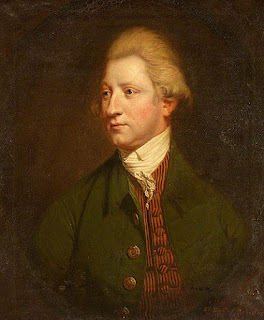The race was won by Lord Staverdale's bay mare Blue Cap. Henry Thomas Fox-Strangways, known as Lord Stavordale from 1756 to 1776, when he inherited the title of Earl of Ilchester on the death of his father, had his family seat at Melbury House, near Evershot, Dorset, some 50 miles from Bath. In 1765, he was 18 and likely still riding his own horses in races.
His Lordship would have paid 5 shillings, about £30 at today's values, to enter Blue Cap if he had subscribed to the race costs and prizes or half a guinea, about £60, if not. These prices only applied if he entered his horses by Friday, the 27th of September, at Mr Dover's alehouse, the Coach and Horses, in Bell Tree Lane, which ran between Stall Street and Bilbury Lane. He was open to accept entries for 2 to 6 each day. If he had not entered by the 27th, he would have had to enter "at the post" on race day at twice the price.
On receiving the horse's entry, Mr Dover would have had the horse officially measured to determine what weight it should carry at the Coach and Horses in "Bell Lane" between the hours of 2 and 6. The Coach and Horses was an alehouse on Bell Tree Lane, between Stall Street and Bilbury Lane.
The entrance money was used to provide a purse for the owner of the horse that came second, providing a win in at least one of the heats.
Before starting his Lordship would have had to have had his horse shod with racing plates by one of the blacksmiths who had paid the organisers a subscription for the privilege.
On arrival at the course, all visitors would have been courted by the many booth holders and liquor sellers who had paid a guinea to the organisers for the opportunity to sell their wares to the well-heeled racing crowd.
The main race was scheduled to start at 3 o’clock each day, but an hour before this, a drum or trumpet would alert runners to the need to weigh in to determine whether or not the rider needed to carry extra weight in pockets usually specially built into their waistcoat and design to ensure it was secure and evenly distributed. Each owner had to pay one shilling to the clerk of the course for the use of the official weights and scales.
Riders were at liberty to wear whatever they chose. Still, most would wear coloured silk or white holland [a plain woven or dull-finish linen] to help the spectators identify runners, waistcoats and drawers or breeches made of a light fabric designed to hug the body, and on their head, a little cap tied on; tight-fitting boots and spurs.
Thus equipped, the rider would mount and ride down to the appointed start. Books from the time advise on tactics. If the horse had more stamina than speed, they recommend trying to win from the front, forcing the pace as much as possible from the start to break the spirit of faster horses. If you had a fast horse, by contrast, they advise holding him behind and coming with a late rush. To conserve a horse's stamina, a ride might hold a horse back in one heat but had to be careful not to be "distanced, " meaning it would be disqualified. This was a rule brought in to discourage riders from giving horses an easy ride in one heat. The distance was a point approximately 240 yards from the finish.
The Complete Sportsman by Thomas Fairfax describes the riding style in vogue at this time.
'The posture to be observed is, that you place yourself upon your twist [the part of the saddle the rider feels between their upper inner thighs], with your knees firm, and your stirrups just at such a length, that your feet, when they are thrust home in them, you can raise yourself a little in the saddle, for your legs, without that allowance, will not be firm when you come to run; the counter-poise of your body must be forward, to facilitate your horse's running, and your elbows must be close to your body; be sure, above all things, that you do not incommode your horse by swaggering this or that way, as some do, for since weight is a great matter in running, and that a troublesome rider is as bad as so much more weight, there is no need to say how necessary it is to take great care of your seat and hand; you must therefore beware of holding yourself by the bridle, or of jobbing your horse's mouth upon any occasion; you must take your right rein in the same hand, holding up horse, &c. as you find it necessary, and every now and then remove the bridle in his mouth. But these things are best learned by experience and practice.'
At the end of each heat, riders would be weighed in great scales and disqualified if they weighed less than when they weighed in at the start.
The horse and rider usually had half an hour between heats to recover and for the grooms to rub down the sweating horses until the drum or trumpet, again, sounded to announce the start of the next heat.
At the end of each heat, owners and spectators would gather at the betting post to exchange bets and set odds on the race's outcome. Vast amounts of money could be wagered and considerable emotion raised. It was common for spectators and owners to follow their chosen horse on horseback over the last part of the race, adding to the confusion and excitement.



